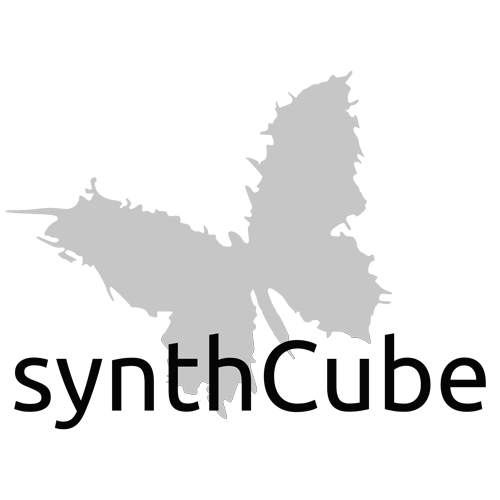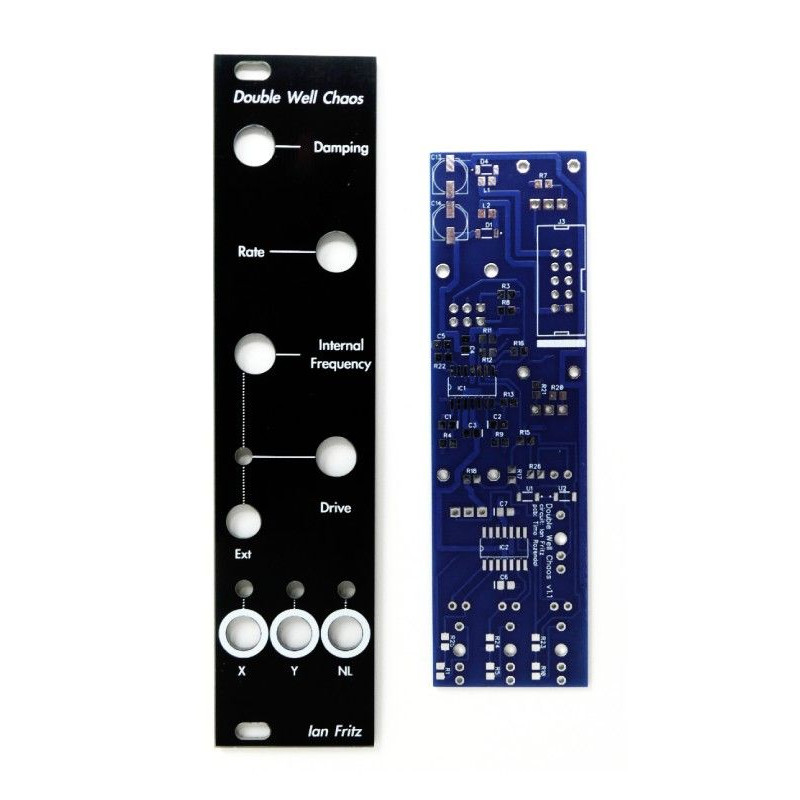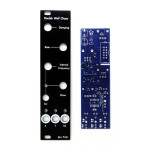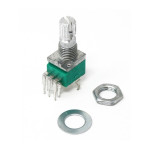Timo Rozendal Ian Fritz Double Well Chaos (Black)
Timo Rozendal Ian Fritz Double Well Chaos (Black)
The diagram below gives a chaos-generating circuit that can easily be built as a synthesizer module or quickly breadboarded for experimentation. It has a manually set evolution rate (or, roughly speaking, frequency) and only requires three opamps. Although quite simple, it can produce a wide range of chaotic signals. It is a circuit analog for a standard textbook problem in chaos theory, that of a particle in an oscillating double-well potential. It requires an external driving oscillator for operation, such as a standard synthesizer LFO or VCO.
The circuit consists of two identical integrators built around opamps "a" and "b", and a nonlinear circuit built around opamp "c", all connected in a loop. The third opamp actually serves triple duty -- in addition to producing a nonlinearity of the form f(x) = x(1-x2), it provides a feedback path for damping of the first integrator as well as a node for injecting the external driving signal.

The oscillation rate is set by the ganged pots R2a and R2b. The damping control R6 sets the amount of negative feedback around the first integrator. The chaos pattern generated depends on these controls, as well as on the driving frequency and amplitude. The circuit operates from frequencies below 1 Hz to several hundred Hz. For a wider operating range, switched "range" capacitors or an OTA-based solution could be used.
 To understand the connection between the actual circuit and the double-well problem, consider the next figure. The drawing in the upper half is a representation of the circuit in terms of the building blocks discussed in the "Up Close" section. The factor "a" represents the signal attenuation by the rate controls. Because of the paths used for the damping and driving signals, each of these is attenuated by R2a. Thus, all integrator inputs are proportional to "a", which means that the time variable may be rescaled to eliminate "a" from the equations. In practice this means that the chaos pattern is independent of the rate setting. The two equations below the drawing represent the system's equations of motion, and after appropriate rescaling and combination the final equation is obtained. This is the classic driven double-well equation.
To understand the connection between the actual circuit and the double-well problem, consider the next figure. The drawing in the upper half is a representation of the circuit in terms of the building blocks discussed in the "Up Close" section. The factor "a" represents the signal attenuation by the rate controls. Because of the paths used for the damping and driving signals, each of these is attenuated by R2a. Thus, all integrator inputs are proportional to "a", which means that the time variable may be rescaled to eliminate "a" from the equations. In practice this means that the chaos pattern is independent of the rate setting. The two equations below the drawing represent the system's equations of motion, and after appropriate rescaling and combination the final equation is obtained. This is the classic driven double-well equation.
The three following scope photos of y = x' vs. x show the effect of increasing drive level (R14) on the chaotic pattern for fixed damping and drive frequency. I will use the mechanical analog to describe the response. At the lowest drive level, the particle exhibits chaotic motion while remaining localized in one of the two potential wells. The motion is elongated towards the origin because the restoring force is weaker there. With increased drive, the motion is still chaotic and the particle jumps erratically between the two wells. Note that there are only six crossings between the wells, so the motion is mostly contained in one of the wells or the other. At the highest drive level, the motion is mainly in the large outer orbits, which means that the motion is rarely confined in either well for a significant period of time.
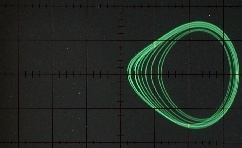


Many other interesting patterns are generated with different values of drive frequency and damping, including many non-chaotic limit-cycle oscillations (regular oscillations with many loops). Additionally, the "NL Out" may be used as a control signal. For a more detailed exposition of the many interesting properties of this system, the following short text may be of interest:
W. Szemplinska-Stupnicka, CHAOS, Bifurcations and Fractals Around Us, World Scientific (2003).
These kits and assembled modules are offered on demand, click the link to learn more.
| Module Parameters | |
| Format | Eurorack |
| Panel Size | 6HP |
